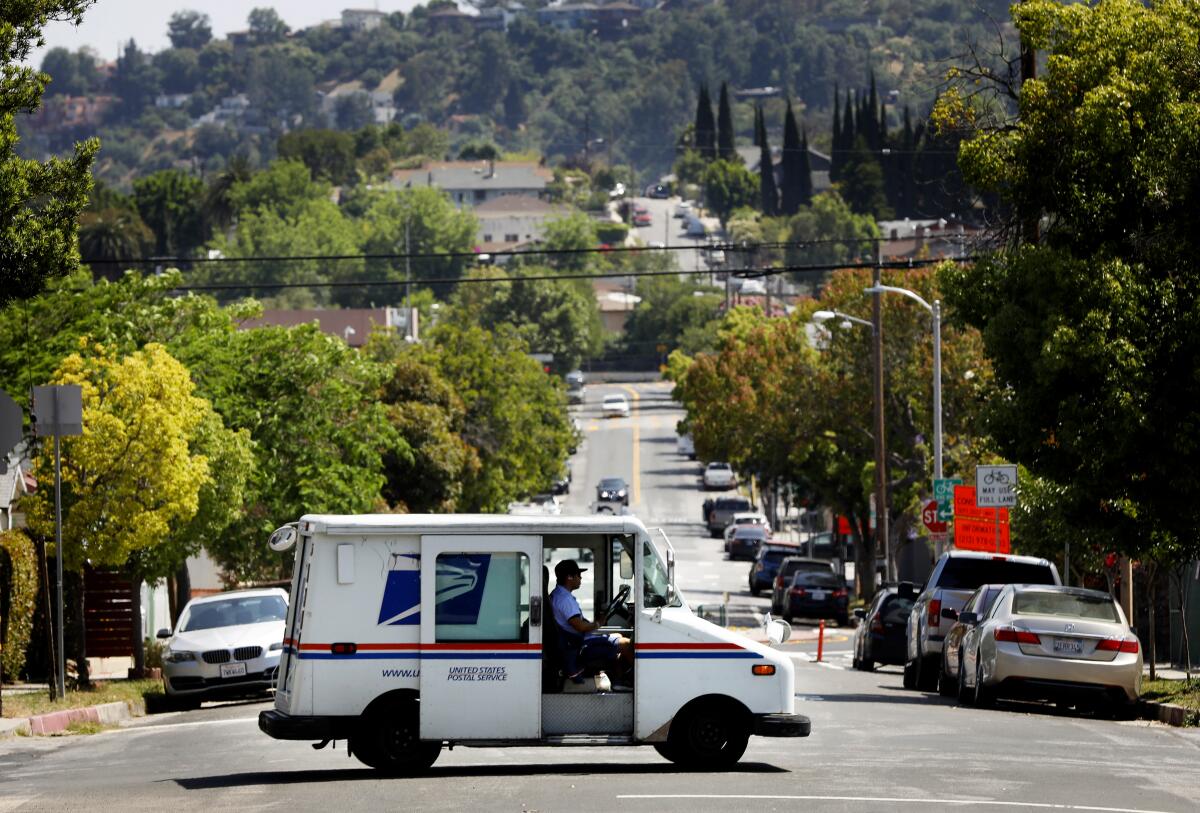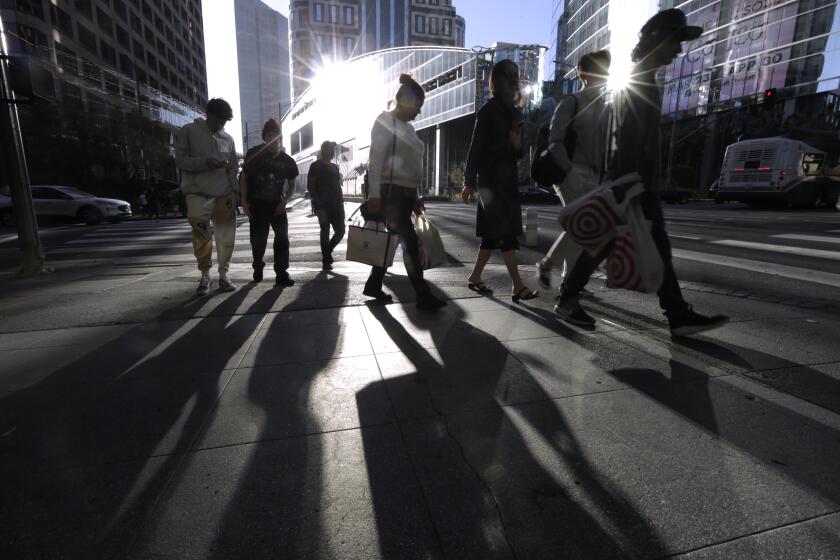L.A. and other cities are recovering, but not their downtowns. Why?

- Share via
A fiscal “doom loop.” A transit “death spiral.” The “office apocalypse.” Since the traumatic disruption of the COVID-19 pandemic, these pessimistic terms have been applied repeatedly to the state of our cities. Analysis of Census data from my Brookings Institution colleague William Frey found that from 2020 to 2021, during the peak of the pandemic, major metropolitan areas including New York and Los Angeles lost a significant number of residents. A net 175,000 people left L.A. for Riverside, the Sun Belt or smaller metros and rural areas.
But new research shows clear signs this trend is reversing. As many downtowns struggle, residential neighborhoods are thriving. While L.A. also lost population in 2022, that year’s rate of population loss was half what it was in 2021. Other cities, such as Seattle and Washington, D.C., have flipped from losses to gains. Yet office vacancy rates continue to rise, and transit ridership remains well below 2019 levels on every major U.S. system. If people are back, where are they?
Not at the office or on the train. Instead, people are enjoying walkable, mixed-use neighborhoods where they can both live and work, in contrast to the 20th century mode of cities and suburbs that rigidly separates work zones from other activities.
The pandemic-driven shift to remote and hybrid work has left office skyscrapers half-empty in downtown Los Angeles and other cities in California and the U.S.
This has benefits not just for individuals but also for communities and places. For example, while overall transit ridership in San Francisco is only 54% of the pre-pandemic level on weekdays, the 22 Fillmore line serving the neighborhood of Mission Bay, just south of the historic downtown, is at 107% of pre-pandemic ridership. In L.A., while retail vacancy downtown is 9.3% and trending upward, the citywide rate is only 6.1%, data from CoStar show. In a diverse range of neighborhoods, retail is close to or even outperforming that average: The vacancy rate is only 5.6% in Echo Park, 6.3% in Inglewood and 6.6% in Boyle Heights. Elsewhere it’s trending down, even approaching zero: 0.5% on Figueroa Street near USC, 1.5% in Los Feliz and 2.3% in Highland Park.
Why are some neighborhoods doing extraordinarily well? These are not the richest parts of L.A. Rather, they gather big, diverse collections of economic, social, physical and civic assets in close proximity. Figueroa, Los Feliz and Highland Park have some of the highest population densities in L.A. County, as well as access to amenities including the USC campus and Griffith and Hermon parks. They are close enough to downtown to be accessible to and from elsewhere in the region. And finally, all of these places are served by hyperlocal place governance entities, including business improvement districts that provide extra coordination and support such as clean-and-safe patrols.
Demand in cities remains strong — so much so, in fact, that in many of the biggest metro areas the concern is not abandonment but affordability. Nowhere in the United States is the housing crisis as acute as Los Angeles, the least affordable metro area in the U.S. Citywide, the average rent for a one-bedroom apartment is more than $2,000. In Los Feliz it’s $2,250, according to CoStar data. Off Figueroa near USC and in Highland Park, you can get a one-bedroom for $1,400 or $1,600, but those sorts of offerings are few and far between. And even those rents are out of reach for many in a city where half of households make $70,000 a year or less. People are leaving L.A. not to ditch a struggling city, but to find housing.
This crisis is a choice, and the solutions for both neighborhood affordability and downtown revitalization are the same: ending policy and infrastructure that segregates people and most types of land use, creating under-resourced neighborhoods as well as downtowns overly dependent on offices.
Policies and practices such as exclusionary zoning and lending discrimination allow some neighborhoods to hoard what they need (e.g. low-flood-risk land and tax revenue to support services) while withholding from others. What if we enabled all people and places to thrive?
Technology, the force that propelled San Francisco to the top, also carried the germs of its doom.
Los Angeles and California have recently made progress in advancing policy reforms, such as the city’s expansion of its adaptive reuse ordinance and the state’s Affordable Housing and High Road Jobs Act, both of which will increase housing production and economic vitality by integrating housing with underperforming retail and offices.
Progress will also require building housing everywhere, including affordable housing as well as transitional and permanent supportive options that meet a broader range of needs than our current one-size-fits-all housing stock. It also makes sense to invest more in basics that proved throughout the pandemic to support quality of life, such as parks and community-based organizations.
The most effective policies to create shared prosperity for neighborhoods and downtowns will raise and share new revenue by explicitly connecting growth with funding to connect historically marginalized communities and places to the regional economy, cultivating their local assets.
Some examples cities are already pursuing include New York’s congestion pricing to fund public transit, Chicago’s Invest South/West to increase economic investment and development in neighborhoods punished by racial segregation, and Seattle’s Equitable Development Initiative, which funnels grant dollars to neighborhoods at high risk of displacement to empower local projects. In addition, L.A. and other cities can directly address the systemic devaluation of Black neighborhoods by enabling new models for commercial real estate ownership that are accessible for local entrepreneurs.
What does the city of the future look like, and who decides? Much of the rhetoric of the current moment is focused on assigning blame for shortcomings. Instead, we need to encourage what has worked to support great neighborhoods and downtowns and make those things accessible to more people — finding common ground, earning community trust and establishing new ways to work together to build something that lasts.
Tracy Hadden Loh is a fellow at Brookings Metro studying commercial real estate and a contributing author to “Hyperlocal: Place Governance in a Fragmented World.”
More to Read
A cure for the common opinion
Get thought-provoking perspectives with our weekly newsletter.
You may occasionally receive promotional content from the Los Angeles Times.








